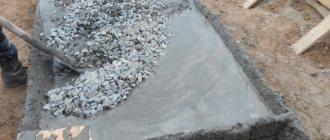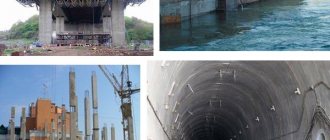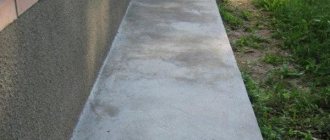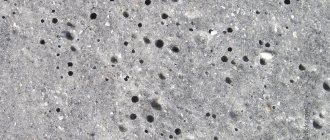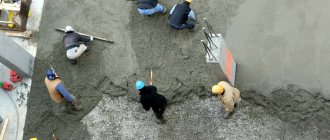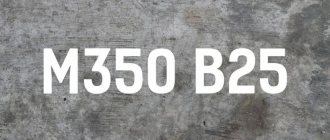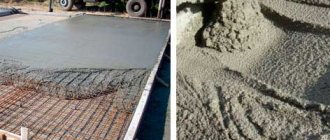Understanding the brands of concrete
It is impossible to overestimate the importance of concrete in construction. Almost no construction project can be completed without it. How to understand the grades of concrete and why the popular rule “put more cement - it will be stronger” is devoid of common sense - in our material.
Concrete, as we know, is a mixture of binder, aggregate and water. We will consider cement concrete (sometimes also non-cement, for example, silicate) with a filler of sand and crushed stone (gravel).
The main indicator is the strength grade of concrete (M50, M100, M200, and so on). This average strength value is used mainly by private owners.
As a rule, design documents indicate the strength class of concrete (guaranteed value). Until 2003, when designating the strength class, the marking with the letter “B” was used (in Russia to this day), since 2003 in Belarus, the marking of concrete above M100 has been designated with the letter “C” (SNB 5.03.01-02). Here is a simplified brand correspondence table. We deliberately do not indicate values for concrete with a strength higher than M350, since such concrete is expensive and its use in private housing construction is impractical.
| Concrete grade | Class | |
| since 2003 | until 2003 | |
| M100 | B7.5 | B7.5 |
| M150 | C8/10 | AT 10 |
| C10/12.5 | B12.5 | |
| M200 | C12/15 | B15 |
| M250 | C16/20 | IN 20 |
| M300 | C18/22.5 | B22.5 |
| M350 | C20/25 | B25 |
Each brand of concrete has a specific area of application. This can be represented schematically in a table.
| Purpose | M100 | M150 | M200 | M250 | M300 | M350 |
| Concrete preparation | + | + | ||||
| Floor screed | + | + | ||||
| Foundation | + | + | + | + | ||
| Stairs | + | + | ||||
| Bearing structures | + | + | ||||
| Floors | + | |||||
| Swimming pools | + |
As you can see, for the most common “consumer” of concrete - the foundation - the fork ranges from M200 to M350. Concrete M200 is the most common, it is most often used for strip foundations, M250 and M300 are used on soft soils, M350 is used for foundations of industrial facilities.
It is not recommended to make any type of foundation yourself, except strip foundation, unless you are a professional builder. For pile, slab and column foundations, you should order a calculation from the designer or at least get advice from an experienced specialist.
In some cases, it is permissible to use “reduced” grades. For example, the grade of concrete for the foundation of a gazebo or other small building may well be M150.
When choosing between brands of concrete for screed, you can be guided by the following rule: M150 is suitable for a non-loaded floor, M200 is better for a loaded floor (for example, in a bathroom with a cast-iron bathtub).
Experts do not recommend “inflating” the grade of concrete; this is an unnecessary expense, since the strength that will ultimately be obtained will be with an unreasonably large margin.
How to calculate how much cement is needed
If construction is carried out according to a project, then, as a rule, a specific amount of concrete of a certain grade is already laid in it. In this case, concrete is delivered to the site by mixer.
If you need to prepare a concrete mixture yourself, you can use the “folk” formula 1: 3: 5 (cement, sand, crushed stone), more precise proportions for each brand are given below.
The composition of concrete grades when using M400 cement is as follows.
| Concrete grade | Mass composition, C : P : Shch (kg) | Volumetric composition per 10 liters of cement, P: Shch (l) | Amount of concrete from 10 liters of cement (l) |
| M100 | 1 : 4,6 : 7,0 | 41 : 61 | 78 |
| M150 | 1 : 3,5 : 5,7 | 32 : 50 | 64 |
| M200 | 1 : 2,8 : 4,8 | 25 : 42 | 54 |
| M250 | 1 : 2,1 : 3,9 | 19 : 34 | 43 |
| M300 | 1 : 1,9 : 3,7 | 17 : 32 | 41 |
If concrete is prepared from M500 cement, the proportions are slightly different.
| Concrete grade | Mass composition, C : P : Shch (kg) | Volumetric composition per 10 liters of cement, P: Shch (l) | Amount of concrete from 10 liters of cement (l) |
| M100 | 1 : 5,8 : 8,1 | 53 : 71 | 90 |
| M150 | 1 : 4,5 : 6,6 | 40 : 58 | 73 |
| M200 | 1 : 3,5 : 5,6 | 32 : 49 | 62 |
| M250 | 1 : 2,6 : 4,5 | 24 : 39 | 50 |
| M300 | 1 : 2,4 : 4,3 | 22 : 37 | 47 |
For example, you need to calculate how much cement is needed for a screed: we make M200 concrete, to prepare it, for 1 kg of 400 grade cement we take 2.8 kg of sand, 4.8 kg of crushed stone and about 0.5 liters of water. You usually need half as much water as cement, but its amount may vary depending on the moisture content of the components.
Construction. Industrial floors - Concrete
The relationship between grades and classes of concrete according to GOST, SNB and European standards
|
Composition and grades of concrete
Concrete is an artificial building material obtained by mixing and hardening a specially selected mixture of binder (cement), aggregates (sand, gravel, crushed stone), and water. In some cases, it may contain special additives. Before the concrete mixture hardens, it can be given any shape, and after hardening, the mixture acquires the properties of stone: good compressive strength, frost resistance, moisture resistance. At the same time, once it has hardened, the concrete no longer gets wet - on the contrary, being immersed in water for a long time, it hardens even more.
How to choose the right brand of concrete mortar
Let us consider the procedure for selecting the grade and class of concrete using a specific example, namely in the case of using the material for the construction of the foundation of individual housing construction. When a builder chooses concrete, he must take into account the weight of the future building, as well as the number of floors. For example, when constructing the foundation of a one-story building, concrete grade M200-M250 is suitable. For the foundation of a house building with 2-3 floors, which will be built, for example, from brick, M300 concrete will be optimal. The use of M400 is not advisable in the construction of private houses, despite the excellent strength and characteristics, because the cost of this brand, as we have already noted, is quite high.
When choosing the right grade of concrete, you also need to consider the following:
- The degree of frost resistance of concrete. This parameter is marked with the English letter “F”, followed by a number in the range from 50 to 300. This indicator determines the number of freezing-thawing cycles with a loss of concrete strength on average up to 5%. The higher the frost resistance index of concrete, the greater the number of “freezing and thawing” a structure made from the above material can withstand. This indicator is very important in the context of the conditions in which the structure or reinforced concrete product will be used. For example, when constructing various types of hydraulic structures, the choice is made of concrete with a high degree of frost resistance. Such concretes are also suitable for the construction of bridge supports.
- The water resistance of concrete indicates the ability to resist the penetration of moisture into the material even under pressure. This indicator can be in the range of 2-20. Indicated by the letter “W.” The numerical value in the marking indicates the level of pressure in the water column and is measured in kgf/cm². When choosing a material for constructing a foundation in soils with a high groundwater content, it is optimal to purchase concrete with high water resistance. This indicator has the so-called hydraulic concrete.
- Plasticity indicates the mobility of a solution. This parameter is temporary, since after setting it does not affect anything. In this case, mobile solutions are used mainly for the manufacture of monolithic structures.
- Hardness or G1-G4. All concrete can be divided into 4 classes based on hardness.
You can order high-quality concrete from us and have it delivered to your construction site. Call our sales managers right now, they will advise on all questions and calculate the required volume of material.
Concrete s20 25 what brand
Development of construction projects involves recommending the brand and/or class of concrete mortar, as well as the reinforcement scheme for the pouring form.
For standard purposes and applications of concrete, its strength is suggested in the range B 15-B 20 (M 200-M 250).
At the same time, the concrete composition M350 and high strength classes from B 25 are recommended for civil and strategic buildings.
The price of M350 concrete is higher, but the cost is compensated by increased strength and density, and allows you to reduce the volume of the solution and the entire structure, and therefore reduce the load on the base of the object.
Areas of application of concrete of various grades
Let us consider in more detail the scope of application of a mixture of concrete of various grades.
Concrete M100
This brand is used mainly for repair work. Construction experts note that this is a rather “weak” concrete, so it is usually used for pouring a thin-layer screed, as a concrete pad. This type of mortar is also used in the manufacture of curbs and sidewalks. Due to the fact that M100 has relatively low frost resistance and water resistance parameters, this type is not suitable for the manufacture of volumetric structures.
Concrete M150
It has characteristics similar to the M100 brand. Note that concrete mortar marked M150 is usually used for the construction of lightweight foundations, but mainly in dry soils - these are rocky or clastic types of soil. This solution hardens quickly, so it is preferred to be used when meeting the shortest possible construction time is extremely important. The composition of such a solution includes cement, sand, coarse aggregate, which is mainly gravel or limestone, various additives that improve the characteristics of the material, as well as water.
Concrete M200
It belongs to the category of fine-grained concrete. It is this solution that is most often used in private construction. For example, foundations for low and light buildings are built from concrete mortar of strength class B15, and are also used for the construction of flights of stairs, internal partitions, and reinforced concrete products. This type of concrete can also be used for pouring and leveling various surfaces. Note that such concrete can withstand a load of 15 MPa without collapsing. When making a solution of the above brand, as a rule, crushed stone with different fractions is used. For example, for filling small areas or in the case of using small formwork, fine-grained crushed stone is chosen. Coarse-grained crushed stone is included in the concrete mixture when it is necessary to build a strip foundation or any structure.
Concrete M 250
It is suitable for building the foundation of a low wooden house or garage building. This concrete is also perfect for pouring foundations in areas with difficult terrain.
Concrete M300
It can be safely classified as universal. It is used in the construction of low-rise buildings, as well as in industrial construction. This type of solution is recommended for use in buildings that will be subject to significant loads during operation. It belongs to the strength B22.5. This material is part of the group of frost-resistant and waterproof types of concrete.
